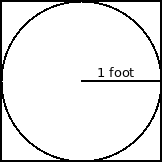To get experience writing, compiling and executing simple pthreads
programs.
Suppose we toss darts randomly at a square dartboard whose sides are 2 feet
in length. Suppose there is also a circle inscribed in the center of the
dartboard with a radius of 1 foot, and an area of π square feet.
If the darts are uniformly distributed on the dartboard, and we always hit
the dartboard, then the number of darts that land inside the circle should
satisfy the equation:
$\frac{\text{number in circle}}{\text{total number of tosses}} =
\frac{\pi}{4}$
since the ratio of the area of the circle to the area of the square is
$\frac{\pi}{4}$.
We can use this to estimate the value of π with the following
algorithm:
- number in circle = 0
- do $N$ times:
- set $x$ to be random number between -1 and 1.
- set $y$ to be random number between -1 and 1.
- set distance to be $x^2 + y^2$.
- if the distance is less than or equal to 1, increment number in circle.
- estimate π as $4 \times \frac{\text{number in circle}}{N}$
This is called a Monte Carlo method because it uses random
sampling.
The larger $N$ is, the more accurate our estimation will be.
You should write a Pthreads program which uses this method to estimate π.
There are two major ways you could do this:
- Have each thread do many samples, and send its "number in circle" count to
the main thread, which will then add them all together for the final estimate.
- Have each thread do many samples, and estimate π, sending the estimate
to the main thread which will average them all together.
You can do this either way.
Details
- Write a Pthreads program which spawns a constant number of threads (this should be defined
at the top of your program).
- Each thread should do a constant number of tosses (this should be a constant as well).
- Rather than calling the regular "rand" function, you should call the thread safe version rand_r.
This function takes a pointer to the "seed" value.
Create a local unsigned int variable for the seed in each thread. So each thread has a different seed, you can assign
it the thread id as its value.
- You can find a random number between -1 and 1 with the expression:
((double) rand_r(&seed) / (double) RAND_MAX) * 2.0 - 1.0
- The main thread should wait for the child threads to finish, then combine the results.
- The main thread should then print the final estimate.
When your program works, it should print out a value approximately equal to π
(e.g. 3.1 - 3.2) when run with suitably large sample size (more than a few thousand total samples).
Analysis
Test your program with the same number of total tosses, but split into more threads as shown in the following table:
| Threads | Tosses Per Thread | Estimate | Time |
| 1 | 100,000,000 | | |
| 2 | 50,000,000 | | |
| 4 | 25,000,000 | | |
| 8 | 12,500,000 | | |
What is the speedup and efficiency of moving to 8 threads?
Use the "time" command to time your runs:
$ time ./a.out
Pi is roughly 3.141625
real 0m0.416s
user 0m2.880s
system 0m0.000s
The "real time" is the one we are interested in.
Submitting
When you're finished, submit both the source code and the analysis (in a text document
of some kind) to Canvas.
